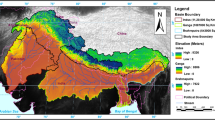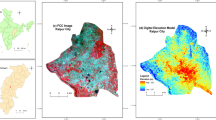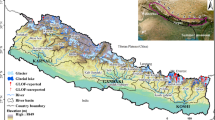Abstract
This study investigated the spatial and temporal variability of snowfall and its concentration across northern **njiang, Northwest China based on the corrected dataset (derived from 26 stations) using a wet-bulb temperature method during the snowfall hydrological years from 1961 to 2017. The snowfall concentration was analyzed by means of three indices: the snowfall concentration index (CI), snowfall concentration degree (SCD), and snowfall concentration period (SCP). The results demonstrated that the snowfall and temperature increased by 5.69 mm and 0.35 °C per decade, respectively, in northern **njiang during the time period from 1961 to 2017. Maximum snowfall occurred at a critical temperature ranging from − 2 to 1 °C. The increased snowfall mainly took place in northern **njiang during winter. The distribution of the high snowfall CI value indicated that the daily snowfall showed a high irregularity in the northern slope of the Tianshan Mountains and the northern Altay Mountains, in which more than 77% snowfall was contributed by the 25% snowfall days in a year. The results of SCP revealed that the snowfall concentrated in northern **njiang during December, with an earlier arrival in the north and east of northern **njiang than in the western part. The SCD results proved that the monthly snowfall was more concentrated in the northern Altay Mountains, Ili Valley, and Boertala Valley than over the eastern part of northern **njiang during a year. The snowfall in almost all stations increased in concentration throughout the year. The obtained study results could provide scientific reference for future water resource management and snow disaster prevention under a warming climate.







Similar content being viewed by others
References
Barnett TP, Adam JC, Lettenmaier DP (2005) Potential impacts of a warming climate on water availability in snow-dominated regions. Nature 438 (7066):303-309
Berghuijs WR, Woods RA, Hrachowitz M (2014) A precipitation shift from snow towards rain leads to a decrease in streamflow. Nat Clim Chang 4:583–586. https://doi.org/10.1038/nclimate2246
Blanchet J, Marty C, Lehning M (2009) Extreme value statistics of snowfall in the Swiss Alpine region. Water Resour Res 45:1–12. https://doi.org/10.1029/2009WR007916
Chen Y, Li Z, Fang G, Li W (2018) Large hydrological processes changes in the transboundary rivers of Central Asia. J Geophys Res Atmos 123:5059–5069. https://doi.org/10.1029/2017JD028184
Coleman JSM, Schwartz RM (2017) An updated blizzard climatology of the contiguous United States (1959-2014): an examination of spatiotemporal trends. J Appl Meteorol Climatol 56:173–187. https://doi.org/10.1175/JAMC-D-15-0350.1
Coscarelli R, Caloiero T (2012) Analysis of daily and monthly rainfall concentration in southern Italy (Calabria region). J Hydrol 416–417:145–156. https://doi.org/10.1016/j.jhydrol.2011.11.047
Diffenbaugh NS, Scherer M, Ashfaq M (2012) Response of snow-dependent hydrologic extremes to continued global warming. Nat Clim Chang 3:379–384. https://doi.org/10.1038/nclimate1732
Ding Y, Yang D, Ye B, Wang N (2007) Effects of bias correction on precipitation trend over China. J Geophys Res Atmos 112:1–11. https://doi.org/10.1029/2006JD007938
Ding B, Yang K, Qin J, Wang L, Chen Y, He X (2014) The dependence of precipitation types on surface elevation and meteorological conditions and its parameterization. J Hydrol 513:154–163. https://doi.org/10.1016/j.jhydrol.2014.03.038
Fan LL, Tang LS, Wu LF, Ma J, Li Y (2014) The limited role of snow water in the growth and development of ephemeral plants in a cold desert. J Veg Sci 25:681–690. https://doi.org/10.1111/jvs.12121
Farinotti D, Longuevergne L, Moholdt G, Duethmann D, Mölg T, Bolch T, Vorogushyn S, Güntner A (2015) Substantial glacier mass loss in the Tien Shan over the past 50 years. Nat Geosci 8:716–722. https://doi.org/10.1038/ngeo2513
Feng S, Hu Q, Qian W (2004) Quality control of daily meteorological data in China, 1951-2000: a new dataset. Int J Climatol 24:853–870. https://doi.org/10.1002/joc.1047
Gaume J, Eckert N, Chambon G, Naaim M, Bel L (2013) Map** extreme snowfalls in the French Alps using max-stable processes. Water Resour Res 49:1079–1098. https://doi.org/10.1002/wrcr.20083
Gjertsen U, Ødegaard V (2005) The water phase of precipitation - a comparison between observed, estimated and predicted values. Atmos Res 77:218–231. https://doi.org/10.1016/j.atmosres.2004.10.030
Guo L, Li L (2015) Variation of the proportion of precipitation occurring as snow in the Tian Shan Mountains, China. Int J Climatol 35:1379–1393. https://doi.org/10.1002/joc.4063
Hao J, Huang F, Liu Y, Li L (2018) Avalanche activity and characteristics of its triggering factors in the western Tianshan Mountains , China. J Mt Sci 15:1397–1411. https://doi.org/10.1007/s11629-018-4941-2
Jennings KS, Winchell TS, Livneh B, Molotch NP (2018) Spatial variation of the rain–snow temperature threshold across the Northern Hemisphere. Nat Commun 1148:1–9. https://doi.org/10.1038/s41467-018-03629-7
Jeppe K. Malmros, Sebastian H. Mernild, Ryan Wilson, Torbern Tagesson, Rasmus Fensholt, (2018) Snow cover and snow albedo changes in the central Andes of Chile and Argentina from daily MODIS observations (2000–2016). Remote Sens Environ 209:240-252
Jiang F, Li X, Wei B, Hu R, Li Z (2009) Observed trends of heating and cooling degree-days in **njiang Province, China. Theor Appl Climatol 97:349–360. https://doi.org/10.1007/s00704-008-0078-5
Kapnick SB, Delworth TL (2013) Controls of global snow under a changed climate. J Clim 26:5537–5562. https://doi.org/10.1175/JCLI-D-12-00528.1
Ke CQ, Li XC, **e H, Ma DH, Liu X, Kou C (2016) Variability in snow cover phenology in China from 1952 to 2010. Hydrol Earth Syst Sci 20:755–770. https://doi.org/10.5194/hess-20-755-2016
Kendall MG (1975) Rank correlation methods. Griffin, London
Kong Y, Pang Z (2012) Evaluating the sensitivity of glacier rivers to climate change based on hydrograph separation of discharge. J Hydrol 434–435:121–129. https://doi.org/10.1016/j.jhydrol.2012.02.029
Krasting JP, Broccoli AJ, Dixon KW, Lanzante JR (2013) Future changes in northern hemisphere snowfall. J Clim 26:7813–7828. https://doi.org/10.1175/JCLI-D-12-00832.1
Li L, Simonovic SP (2002) System dynamics model for predicting floods from snowmelt in north American prairie watersheds. Hydrol Process 16:2645–2666. https://doi.org/10.1002/hyp.1064
Li X, Jiang F, Li L, Wang G (2011) Spatial and temporal variability of precipitation concentration index, concentration degree and concentration period **njiang. China Int J Climatol 31:1679–1693. https://doi.org/10.1002/joc.2181
Li D, Wrzesien ML, Durand M, Adam J, Lettenmaier DP (2017a) How much runoff originates as snow in the western United States, and how will that change in the future? Geophys Res Lett 44:6163–6172. https://doi.org/10.1002/2017GL073551
Li J, Fan K, Xu J, Powell AM, Kogan F (2017b) The effect of preceding wintertime Arctic polar vortex on springtime NDVI patterns in boreal Eurasia, 1982–2015. Clim Dyn 49:23–35. https://doi.org/10.1007/s00382-016-3324-z
Li Q, Yang T, Qi Z, Li L (2018) Spatiotemporal variation of snowfall to precipitation ratio and its implication on water resources by a regional climate model over **njiang, China. water 10. https://doi.org/10.3390/w10101463
Li Q, Yang T, Zhou H, Li L (2019) Patterns in snow depth maximum and snow cover days during 1961–2015 period in the Tianshan Mountains, Central Asia. Atmos Res 228:14–22. https://doi.org/10.1016/j.atmosres.2019.05.004
Ma N, Zhang Y, Guo Y, Gao H, Zhang H, Wang Y (2015) Environmental and biophysical controls on the evapotranspiration over the highest alpine steppe. J Hydrol 529:980–992. https://doi.org/10.1016/j.jhydrol.2015.09.013
Mahanama S, Livneh B, Koster R, Lettenmaier D, Reichle R (2012) Soil moisture, snow, and seasonal streamflow forecasts in the United States. J Hydrometeorol 13:189–203. https://doi.org/10.1175/JHM-D-11-046.1
Mann HB (1945) Nonparametric tests against trend. Econometrica 13:245–259
Marks D, Dozier J (1992) Climate and energy exchange at the snow surface in the alpine region of the Sierra Nevada 2. Snow cover energy balance. Water Resour Res 28(11):3043–3054
Martin-Vide J (2004) Spatial distribution of a daily precipitation concentration index in peninsular Spain. Int J Climatol 24:959–971. https://doi.org/10.1002/joc.1030
Marty C, Blanchet J (2012) Long-term changes in annual maximum snow depth and snowfall in Switzerland based on extreme value statistics. Clim Chang 111:705–721. https://doi.org/10.1007/s10584-011-0159-9
Matsuo T, Sasyo Y, Sato Y (1981) Relationship between types of precipitation on the ground and surface meteorological elements. J Meteorol Soc Japan 59:462–476. https://doi.org/10.2151/jmsj1965.59.4_462
Murray FW (1967) On the Computation of Saturation Vapor Pressure. J Appl Meteorol 6 (1):203–204
Nicolet G, Eckert N, Morin S, Blanchet J (2015) Inferring spatio-temporal patterns in extreme snowfall in the French Alps using max-stable processes. Procedia Environ Sci 26:24–31. https://doi.org/10.1016/j.proenv.2015.05.018
Nicolet G, Eckert N, Morin S, Blanchet J (2016) Decreasing spatial dependence in extreme snowfall in the French Alps since 1958 under climate change. J Geophys Res 121:8297–8310. https://doi.org/10.1002/2016JD025427
Norris J, Carvalho LMV, Jones C, Cannon F (2015) WRF simulations of two extreme snowfall events associated with contrasting extratropical cyclones over the western and central Himalaya. J Geophys Res 120:3114–3138. https://doi.org/10.1002/2014JD022592
O’Gorman PA (2014) Contrasting responses of mean and extreme snowfall to climate change. Nature 512:416–418. https://doi.org/10.1038/nature13625
Peng D, Zhou T (2017) Why was the arid and semiarid Northwest China getting wetter in the recent decades? J Geophys Res Atmos 122:9060–9075. https://doi.org/10.1002/2016JD026424
Peng S, Piao S, CIAIS P et al (2010) Change in winter snow depth and its impacts on vegetation in China. Glob Chang Biol 16:3004–3013. https://doi.org/10.1111/j.1365-2486.2010.02210.x
Royé D, Martin-Vide J (2017) Concentration of daily precipitation in the contiguous United States. Atmos Res 196:237–247. https://doi.org/10.1016/j.atmosres.2017.06.011
Schneebeli M, Laternser M (2004) A probabilistic model to evaluate the optimal density of stations measuring snowfall. J Appl Meteorol 43:711–719. https://doi.org/10.1175/2101.1
Sen PK (1968) Journal of the American statistical estimates of the regression coefficient based on Kendall’s tau. J Am Stat Assoc 63:1379–1389. https://doi.org/10.1080/01621459.1968.10480934
Shang H, Yan J, Zhang X (2011) El Ni??o-Southern Oscillation influence on winter maximum daily precipitation in California in a spatial model. Water Resour Res 47:1–9. https://doi.org/10.1029/2011WR010415
Shi Y, Shen Y, Kang E, Li D, Ding Y, Zhang G, Hu R (2007) Recent and future climate change in Northwest China. Clim Chang 80:379–393. https://doi.org/10.1007/s10584-006-9121-7
Shi W, Yu X, Liao W, Wang Y, Jia B (2013) Spatial and temporal variability of daily precipitation concentration in the Lancang River basin, China. J Hydrol 495:197–207. https://doi.org/10.1016/j.jhydrol.2013.05.002
Shin H, Park M, Chae H, et al (2013) Study of snow depletion characteristics at two mountainous watersheds using NOAA AVHRR time series data. 29:15–24
Sun J, Wang H, Yuan W, Chen H (2010) Spatial-temporal features of intense snowfall events in China and their possible change. J Geophys Res Atmos 115:1–8. https://doi.org/10.1029/2009JD013541
Trujillo E, Molotch NP, Goulden ML, Kelly AE, Bales RC (2012) Elevation-dependent influence of snow accumulation on forest greening. Nat Geosci 5:705–709. https://doi.org/10.1038/ngeo1571
Vehviläinen B (1992) Snow cover models in operational watershed forecasting, chap. 6. National Board of Waters and the Environment, Helsinki, pp 18–20
Vyshkvarkova E, Voskresenskaya E, Martin-Vide J (2018) Spatial distribution of the daily precipitation concentration index in southern Russia. Atmos Res 203:36–43. https://doi.org/10.1016/j.atmosres.2017.12.003
Wang SP, Jiang FQ, Hu RJ, Zhang YW (2013a) Temporal and spatial variability of extreme snowfall indices over northern **njiang from 1959/1960 to 2008/2009. Nat Hazards Earth Syst Sci Discuss 1:7059–7092. https://doi.org/10.5194/nhessd-1-7059-2013
Wang W, **ng W, Yang T, Shao Q, Peng S, Yu Z, Yong B (2013b) Characterizing the changing behaviours of precipitation concentration in the Yangtze River basin, China. Hydrol Process 27:3375–3393. https://doi.org/10.1002/hyp.9430
Wang K, Zhang L, Qiu Y, Ji L, Tian F, Wang C, Wang Z (2015) Snow effects on alpine vegetation in the Qinghai-Tibetan plateau. Int J Digit Earth 8:56–73. https://doi.org/10.1080/17538947.2013.848946
Wang L, Yao ZJ, Jiang LG, Wang R, Wu SS, Liu ZF (2016) Changes in climate extremes and catastrophic events in the Mongolian plateau from 1951 to 2012. J Appl Meteorol Climatol 55:1169–1182. https://doi.org/10.1175/JAMC-D-14-0282.1
Wang S, Ding Y, Jiang F et al (2017) Defining indices for the extreme snowfall events and analyzing their trends in northern **njiang, China. J Meteorol Soc Japan Ser II 95:287–299. https://doi.org/10.2151/jmsj.2017-016
Wang X, Wang T, Guo H, Liu D, Zhao Y, Zhang T, Liu Q, Piao S (2018a) Disentangling the mechanisms behind winter snow impact on vegetation activity in northern ecosystems. Glob Chang Biol 24:1651–1662. https://doi.org/10.1111/gcb.13930
Wang X, Wu C, Peng D, Gonsamo A, Liu Z (2018b) Snow cover phenology affects alpine vegetation growth dynamics on the Tibetan plateau: satellite observed evidence, impacts of different biomes, and climate drivers. Agric For Meteorol 256–257:61–74. https://doi.org/10.1016/j.agrformet.2018.03.004
Xu M, Kang S, Wu H, Yuan X (2018) Detection of spatio-temporal variability of air temperature and precipitation based on long-term meteorological station observations over Tianshan Mountains, Central Asia. Atmos Res 203:141–163. https://doi.org/10.1016/j.atmosres.2017.12.007
Yang D (2014) Double Fence Intercomparison Reference (DFIR) vs. bush gauge for “true” snowfall measurement. J Hydrol 509:94–100. https://doi.org/10.1016/j.jhydrol.2013.08.052
Yang D, Shi Y, Kang E, Zhang Y, Yang X (1991) Results of solid precipitation measurement intercomparison in the alpine area of Urumqi River basin. Chin Sci Bull:1105–1109
Yang D, Goodison BE, Metcalfe JR et al (1999) Bias correction of precipitation data for Greenland. J Geophys Res 105:6171–6182
Yang T, Li Q, Ahmad S, Zhou H, Li L (2019) Changes in snow phenology from 1979 to 2016 over the Tianshan Mountains, Central Asia. Remote Sens 11:499. https://doi.org/10.3390/rs11050499
Yao T, Thompson L, Yang W, Yu W, Gao Y, Guo X, Yang X, Duan K, Zhao H, Xu B, Pu J, Lu A, **ang Y, Kattel DB, Joswiak D (2012) Different glacier status with atmospheric circulations in Tibetan plateau and surroundings. Nat Clim Chang 2:663–667. https://doi.org/10.1038/nclimate1580
Ye H (2008) Changes in frequency of precipitation types associated with surface air temperature over northern Eurasia during 1936-90. J Clim 21:5807–5819. https://doi.org/10.1175/2008JCLI2181.1
Ye B, Yang D, Ding Y, Han T, Koike T (2005) A bias-corrected precipitation climatology for China. J Hydrometeorol 5:1147–1160. https://doi.org/10.1175/jhm-366.1
Zhang L, Qian Y (2003) Annual distribution features of precipitation in China and their interannual variations. Acta Meteorol Sin 17:146–163
Zhang Q, Xu CY, Gemmer M, Chen YD, Liu C (2009) Changing properties of precipitation concentration in the Pearl River basin, China. Stoch Environ Res Risk Assess 23:377–385. https://doi.org/10.1007/s00477-008-0225-7
Zhang Q, Singh VP, Li J, Jiang F, Bai Y (2012) Spatio-temporal variations of precipitation extremes in **njiang, China. J Hydrol 434–435:7–18. https://doi.org/10.1016/j.jhydrol.2012.02.038
Zhang F, Ahmad S, Zhang H, Zhao X, Feng X, Li L (2016) Simulating low and high streamflow driven by snowmelt in an insufficiently gauged alpine basin. Stoch Env Res Risk A 30:59–75. https://doi.org/10.1007/s00477-015-1028-2
Zhang R, Liang T, Feng Q, Huang X, Wang W, **e H, Guo J (2017) Evaluation and adjustment of the AMSR2 snow depth algorithm for the northern **njiang region, China. IEEE J Sel Top Appl Earth Obs Remote Sens 10:3892–3903. https://doi.org/10.1109/JSTARS.2016.2620521
Zhao Y, Wang MZ, Huang AN, Li HJ, Huo W, Yang Q (2014) Relationships between the West Asian subtropical westerly jet and summer precipitation in northern **njiang. Theor Appl Climatol 116:403–411. https://doi.org/10.1007/s00704-013-0948-3
Zhao C, Yao S, Ding Y, Wang J (2015) Detection of precipitation variability based on entropy over nearly 50 years in **njiang, northwestern China. Theor Appl Climatol 122:609–618. https://doi.org/10.1007/s00704-014-1318-5
Zhou B, Wang Z, Shi Y, Xu Y, Han Z (2018) Historical and future changes of snowfall events in China under a warming background. J Clim 31:5873–5889. https://doi.org/10.1175/JCLI-D-17-0428.1
Zubieta R, Saavedra M, Silva Y, Giráldez L (2017) Spatial analysis and temporal trends of daily precipitation concentration in the mantaro river basin: Central Andes of Peru. Stoch Environ Res Risk Assess 31:1305–1318. https://doi.org/10.1007/s00477-016-1235-5
Acknowledgments
The authors would like to thank the National Meteorological Administration of China (http://data.cma.cn) for providing downloadable daily climate data series in the study area and Dr. L. X. Li from Ontario Veterinary Medical Association for her linguistic assistance during the revision of this manuscript.
Funding
This study was supported by the projects of the National Natural Science Foundation of China (NSFC Grant No. 41401030, U1703241), National Project of Investigation of Basic Resources for Science and Technology (No. 2017FY100501).
Author information
Authors and Affiliations
Corresponding author
Additional information
Publisher’s note
Springer Nature remains neutral with regard to jurisdictional claims in published maps and institutional affiliations.
Appendices
Appendix 1: Tmin, Tmax, and Tw
The Tmin and Tmax are given below:
where ∆T represents the temperature difference between the snow probability and the cumulative probability of snow and sleet. ∆S represents a temperature scale. T0 is the temperature which determines the occurrence probability of snow and rain. ln2 stands for the equivalent to RH = 78%. If RH < 78%, Tmin and Tmax are equal; otherwise, Tmin and Tmax demonstrate different values (Ding et al. 2014). ∆T, ∆S, and T0 depend on RH and could be calculated using the following equation:
where RH is the mean daily relative humidity (range [0, 1]) and Z the elevation (km) of the meteorological station.
TW is the wet-bulb temperature (°C) and could be calculated below:
where Ta represents the daily air temperature (°C) and Ps stands for the daily air pressure (hPa), and esat shows the saturated vapor pressure (hPa). According to Tetens’s empirical formula (Murray 1967), esat could be calculated as below:
Appendix 2: K = 1/catch ratio (CR)
CR is calculated from the air temperature and wind speed, expressed as follows (Ye et al. 2005):
where Ws demonstrates the wind speed at a 10 m height (m s−1).
Rights and permissions
About this article
Cite this article
Yang, T., Li, Q., Liu, W. et al. Spatiotemporal variability of snowfall and its concentration in northern **njiang, Northwest China. Theor Appl Climatol 139, 1247–1259 (2020). https://doi.org/10.1007/s00704-019-02994-7
Received:
Accepted:
Published:
Issue Date:
DOI: https://doi.org/10.1007/s00704-019-02994-7




